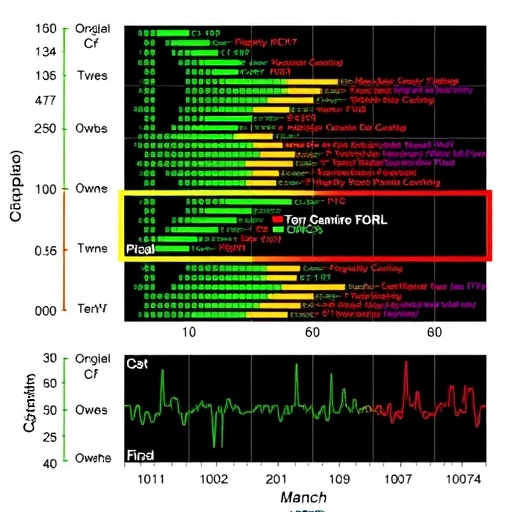In a groundbreaking study published in Cell Reports, researchers have unveiled an unexpectedly expansive role of the Origin Recognition Complex (ORC) in regulating gene expression by modulating epigenetic landscapes and chromosomal architecture in human cells. Traditionally acknowledged for its pivotal function in initiating DNA replication, ORC is now emerging as a multifaceted regulator influencing chromatin dynamics with broad implications for understanding cellular gene regulation mechanisms.
The six-subunit ORC, originally characterized in yeast as an essential factor for marking DNA replication origins, has long been suspected to possess additional functions beyond replication initiation. Previous experiments in simpler eukaryotes hinted at ORC’s involvement in structuring chromatin, the intricate DNA-protein complex fundamental to genome organization. However, the precise ways in which ORC contributes to epigenetic regulation and gene transcription in mammalian systems remained poorly understood until now.
Led by Anindya Dutta, Ph.D., at the University of Alabama at Birmingham, the research team employed sophisticated knockdown strategies targeting individual ORC subunits in human cancer cell lines. These experiments revealed a striking phenomenon wherein individual ORC components bind to distinct DNA sites independently rather than as a uniform hexameric complex. This selective and differential DNA binding challenges the longstanding view that ORC functions exclusively as a six-subunit entity when engaging with chromatin.
Delving deeper, the study demonstrated that the binding by distinct ORC subunits directly impacts gene expression profiles. Specifically, ORC2 exhibited a dualistic role: at certain genomic loci, ORC2 binding condensed chromatin structure and recruited repressive histone modifications, thereby silencing gene activity. Contrarily, at other locations, ORC2 facilitated chromatin opening and gene activation, underscoring a nuanced regulatory capacity that varies with genomic context.
An especially intriguing discovery pertains to ORC2’s interaction with CTCF, a major architectural protein often dubbed the “master weaver” of the genome for its critical role in orchestrating DNA loop formation and higher-order chromatin folding. ORC2 binding was found to obstruct CTCF recruitment at specific DNA sites, effectively preventing the establishment of alternative loop anchor points. This exclusion appears to modulate three-dimensional genome topology and influence transcriptional outputs downstream.
In absence of ORC2, however, previously blocked CTCF sites become accessible, leading to the genesis of novel chromatin loops. At select gene loci, this remodeling results in physical separation of enhancers from promoters—key regulatory DNA elements—thereby dampening gene expression and promoting the spread of repressive epigenetic marks. This mechanism highlights an unappreciated interplay between replication initiation components and genome architectural regulators that collectively orchestrate gene expression.
Despite the perturbations in gene regulation, the cell lines with ORC subunit knockdowns remain viable and carry out DNA replication using conventional origins. This resilience suggests that while ORC’s canonical replication function persists, its independent subunit actions diversify the complexity of epigenetic and transcriptional regulation. The “rescue” cell models—where wild-type ORC genes were reintroduced—allowed precise dissection of individual subunit roles in chromatin biology, unveiling comprehensive insights into the distinctive regulatory capacities of ORC components.
One of the immense challenges confronting this study was the sheer scale of the human genome, which, if stretched linearly, would span over six feet in length within a nucleus barely microns across. Understanding the dynamic folding and unfolding of this vast polynucleotide chain demands refined approaches. By mapping ORC subunit binding sites and correlating them with histone modification patterns and chromatin conformation data, the researchers provided a detailed picture of how ORC shapes epigenetic landscapes at a genome-wide scale.
The study underscored its importance not only by expanding fundamental genomic science but also by raising potential clinical questions. Considering ORC’s involvement in cancer cell lines, the multifaceted regulatory functions of ORC subunits might be relevant to tumor biology and therapeutic strategies targeting chromatin regulators. Insights into ORC-mediated modulation of gene expression could pave the way for novel interventions aimed at correcting epigenetic dysregulation in disease contexts.
The comprehensive investigation was carried out through collaborative efforts spanning institutions, including the University of Alabama at Birmingham, University of Virginia School of Medicine, and Case Western Reserve University. Their integrative methodology combined molecular genetics, chromatin immunoprecipitation sequencing, transcriptomics, and chromosomal conformation capture technologies to unravel these complex regulatory networks.
This pioneering research fundamentally reshapes our understanding of ORC from a replication origin-defining complex to a versatile epigenetic regulator with profound influence over chromatin structure and gene activity. By revealing how individual ORC subunits govern DNA accessibility, repressive versus activating chromatin states, and three-dimensional genome architecture, these findings open new avenues in epigenetics research and genome biology.
Future studies inspired by this work may explore the biochemical mechanisms underlying ORC subunit specificity in chromatin binding, the exact molecular basis for antagonism with CTCF, and the broader physiological and pathological implications of ORC-mediated chromatin regulation in normal and diseased human tissues. Such endeavors promise to deepen our appreciation of the genome’s regulatory complexity and its impact on health and disease.
Subject of Research: Cells
Article Title: Regulation of epigenetics and chromosome structure by human ORC2
News Publication Date: 24-Jun-2025
Web References:
https://dx.doi.org/10.1016/j.celrep.2025.115816
References:
Dutta, A., Su, Z., Zang, C., Tian, M., Wang, Z., Shibata, E., Shibata, Y., Yang, T., Jin, F. (2025). Regulation of epigenetics and chromosome structure by human ORC2. Cell Reports. https://doi.org/10.1016/j.celrep.2025.115816
Image Credits: UAB
Keywords: Functional genomics, Genomic methylation, Transcriptomes, Genome mapping, Genome organization, Genomic analysis, Human genetics




